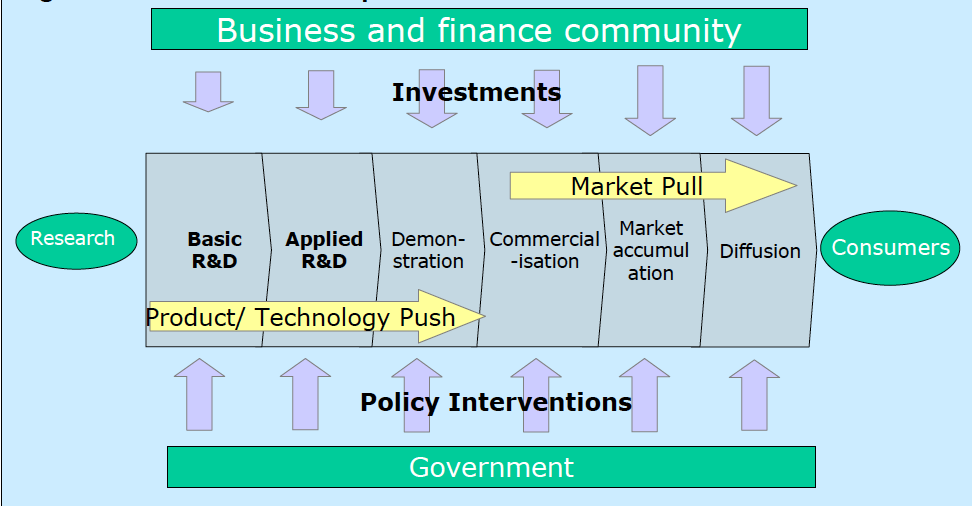The Innovation Process and Climate Change (According Nicholas Stern)
Humanity in general has been concerned in the last decades with the process of climate change, its origins, its process and its impacts to normal life on the planet. Although varying degrees and interpretations around the world, the climate change it is a constant discussion in scientific, financial and governmental forums of several countries and in international meetings.
According to Nicholas Stern in his book The Blueprint for Safer Planet, climate change would be simplified in a cause-and-effect process in four phases:
- Increased human activity in each region of the planet as the main element of change in the pattern of global GHG emissions mainly in the last decades.
- Emissions of GHG on the planet and migration to the single stock in the atmosphere, also increasing its concentration.
- Higher concentration of GHG in the atmosphere exacerbating the physical effect of greenhouse gases with the result of the greater retention of heat and increase of temperature in the planet.
- Climate change due to changes in temperature and its impacts on mankind, that is, related to its own impact on the anthropic, biotic and physical environments.
In each of these phases, one notices that scientists, economists and rulers have positioned themselves in a somewhat divergent way. However, over time certain convergence is perceived in the interpretation of the cause-effect relationship throughout the process, just as there is a certain agreement with the dimensions in the impact on humanity.
Thus, according to Stern, the low carbon economy is a proposal that is necessary when an intensive human activity occurs (peculiar to the 1st phase mentioned above). This economy would be called low carbon because it would emit GHG or gases equivalent to carbon dioxide in a reduced way, therefore not causing the consequences described in the other phases; that is, the negative additional effects that impact humanity.
Thus, it is low carbon, because it emits less GHG, and is referred to as economy, since it is understood as actions of the society itself that would generate this reduction due to changes in its economy.
Otherwise, it can be understood that a low carbon economy is an economic model with low energy consumption, low pollution and low GHG emissions. The key issue of the low carbon economy is to realize high energy efficiency, clean energy development mechanisms, pursuit of sustainable production, and include technological innovation in energy production, emission reduction, of the economy itself.
There are no conventions around the world that include limits on emissions values to explicitly define whether or not an economy is low carbon. However, one can measure an economy in the ranking of an economic group to which it belongs (for example, to measure the per capita carbon intensity of the economy analyzed in the G20 or in the geopolitical sphere to which it belongs).
This proposed economy will then be evaluated and managed nation-by-nation, with national programs introducing low-carbon economies with multilateral integration with other nations, internal management of regions, states / departments / provinces and city halls, that is, hierarchy of public management within the scope of each nation.
Countries with low carbon economies would thus typically be nations that have been able to introduce practices that are considered up-to-date and effective in reducing GHG emissions. And they are compatible with reducing the risk of climate change on the planet.
In another work by Nicholas Stern, “The Economics of Climate Change: the Stern Review”, innovation is crucial in reducing the costs of technologies. A better understanding of this complex process is needed to find out what policies may be needed to encourage companies to offer the low-emission technologies of the future.
The author defines innovation as the successful exploration of new ideas. Four types of innovation were identified in relation to technological change:
- Incremental innovations
- Radical innovations
- Changes in technological systems
- Changes in the technical-economic paradigm.
The following figure summarizes the innovation process:

Innovation is much more than invention: it is a process over time.
In the above process, important agents for the innovation steps are perceived. An area focused on research as seed of the process, as the typical cradle of innovation, until arriving at the typical end of the process—the final consumer. The government fostering innovations through grants, laws, incentives and from the regulation of research and academic activity; and the business and financial community (companies) participating in the process aiming to prioritize for their part with the laws of the market itself the commercially promising technologies.
A complete and widespread process of innovation increases the chances of exploiting differentiated and disruptive technologies, allowing for improvements in current processes or even a revolution in them.
[wp_ad_camp_1]